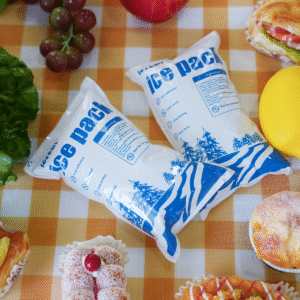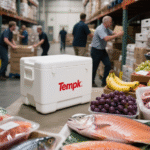Dry Ice Packs for Shipping Frozen Food: 2025 Guide
If you need rock‑solid frozen delivery, dry ice packs for shipping frozen food are your most dependable tool. Start with 5–10 lb of dry ice per 24 horas and add a buffer day for delays. Label UN1845 with a Class 9 diamond (100 milímetros), and mind USPS/IATA limits. This guide shows you how much to use, how to pack it, and how to pass checks the first time.
-
How much dry ice per 24–72 hours? A quick, field‑tested sizing method with buffers.
-
How to pack and vent safely? A 15‑minute packout you can standardize.
-
What labels and documents are required? UN1845, Aula 9, USPS/IATA essentials.
-
Dry ice vs gel packs vs PCM? When to mix coolants to cut weight and cost.
-
What’s new in 2025? Proposed FSMA 204 extension and monitoring options.
How much dry ice packs for shipping frozen food do you need?
Short answer: Use 5–10 lb per 24 horas of transit for most insulated parcels, then add an extra 24 horas as a delay buffer. Insulation quality, ambient heat, and box volume drive the final number. Start with the range; validate with pilots.
Why it works for you: You control risk with a simple rule that matches carrier guidance. A small overage is cheaper than a reship. For summer routes or 1.5″ EPS, plan the high end; for 2″ EPS/VIP or mild weather, the low end usually holds.
Quick estimator (copy‑paste)
Example: 48 h, 1.5″ EPS, hot lane → 0.35 × 48 × 1.2 ≈ 20 lb, plus buffer if needed.
| Transit goal | Typical shipper | Starting dry ice (24 h) | What it means for you |
|---|---|---|---|
| 24 h | 1.5″ EPS, 10–20 L | 5–8 lb | Good for overnight; add 2–4 lb in summer. |
| 48 h | 1.5–2″ EPS | 10–16 lb | Most 2‑day lanes; keep pack tight. |
| 72 h | 2″ EPS+/validated | 18–24 lb | Long/hot lanes; validate before go‑live. |
Practical tips that change the math
-
Place dry ice on top and around the product (cold sinks downward). Fill voids to limit convection.
-
Right‑size the shipper to reduce sublimation and dimensional weight.
-
Pre‑freeze the payload (≤0°F) e pre‑cool the shipper to slow the first‑hour heat spike.
Real case: A D2C steak brand increased summer 2‑day dry ice from 8 lb to 12 lb in 1.5″ EPS and cut warm‑arrival complaints by 62% during July–August.
How to pack dry ice packs for shipping frozen food safely (15 minutos)
Core steps:
Freeze product, line EPS, load payload, place dry ice on top in a ventable wrap, loosely close liner, seal shipper, and label. Keep a vent path—never airtight. This setup is fast, repeatable, and passes acceptance checks.
Rotulagem & documents: UN1845, Aula 9, USPS/IATA must‑knows
Air (IATA PI 954):
-
Mark UN1845 e “Carbon dioxide, solid” / “Dry ice”, show net dry ice weight (kg).
-
Apply Aula 9 hazard label, 100 mm × 100 milímetros; ensure venting.
-
Max 200 kg/package (well above parcel needs).
-
When cooling non‑dangerous goods (por exemplo, frozen food), um Shipper’s Declaration is often not required; include details on the AWB (UN1845, proper name, package count, net kg).
USPS domestic air: ≤5 lb dry ice per mailpiece, no international mail with dry ice. Use Packaging Instruction 9UM; mark and vent correctly.
Safety basics: Wear insulated gloves, ventilate work areas, and never seal dry ice in airtight containers. ~1 lb → ~250 L of CO₂ gas; avoid confined spaces.
Compliance quick table
| Mode | What to show | Limits & notes | Why it matters |
|---|---|---|---|
| Express/Air | UN1845, proper name, net kg; Aula 9 (100 milímetros); vent path | ≤200 kg/package | Clean audits, fewer holds. |
| USPS Air | “Dry Ice/Carbon Dioxide, solid”, net weight; follow 9A | ≤5 lb/mailpiece; no international | Avoid returns or refusals. |
| Ground (parcel) | Mark Gelo Seco; still vent packaging | Carrier procedures apply | Smoother acceptance/pickup. |
Field‑tested packing advice
-
Double‑bag melt‑prone foods; keep dry ice physically separated from unpackaged food.
-
Use 1.5″–2″ EPS or validated shippers for frozen lanes; thicker walls reduce ice load.
-
Warn recipients a box contains dry ice; ask them to open in a ventilated area.
Actual scenario: UM 23 L validated shipper held below –4°F for 96+ hours under a standard thermal profile when loaded correctly—proof that process beats guesswork.
Dry ice packs for shipping frozen food vs gel packs vs PCM—what should you choose?
Bottom line:
-
Escolher gelo seco para deep‑frozen (≤0°F) and “solid on arrival.”
-
Escolher pacotes de gel para refrigerado (34–50°F) lanes.
-
Escolher PCM (por exemplo, –21°C) for repeatable set points or to mix with dry ice to smooth temps and cut mass.
Mixing strategies that save weight
Pair –21°C PCM under the payload with dry ice on top to reduce total dry ice and soften temperature swings—especially on 48–72 h routes. Validate before scaling.
| Refrigerant | Target range | Prós | Watch‑outs | Meaning for you |
|---|---|---|---|---|
| Gelo seco (UN1845) | ≤0°F | Very cold; no meltwater | Hazmat rules; vent | Best for frozen integrity |
| Pacotes de gel | 34–50°F | Simple; reutilizável | Not cold enough for frozen | Ideal for short chilled lanes |
| PCM (–21°C) | Deep‑frozen setpoint | Predictable curve; reutilizável | Cost; precondition exactly | Great as hybrid with dry ice |
2025 developments and trends in dry ice packs for shipping frozen food
What changed: Em Agosto 2025, FDA proposed extending FSMA 204 traceability compliance to July 20, 2028 (comments due Setembro 8, 2025). Plan tech roadmaps and data capture accordingly.
Real‑time monitoring: Affordable IoT devices (por exemplo, SenseAware) now provide temperature/location alerts for high‑risk lanes—use them during pilots and peak weeks to tune packouts.
Latest progress at a glance
-
Regulatory clarity: IATA’s 2025 dry‑ice acceptance checklist re‑emphasizes UN1845 marks, 100 mm Class 9, and venting—clean, auditable steps.
-
Carrier guidance: FedEx reiterates 5–10 lb/24 h and suggests a +24 h buffer for delays—simple rule, fewer surprises.
-
USPS caps: Domestic air ≤5 lb of dry ice per mailpiece; international prohibited—route heavy frozen via express carriers.
Market insight: Expect more VIP shippers and hybrid PCM+dry‑ice designs to cut weight and waste while preserving hold time on 2–4 day lanes. Use validation runs, not guesswork, to lock recipes by season and lane.
Perguntas frequentes
Q1: How many dry ice packs for shipping frozen food do I need for 48 horas?
Start near 14–20 lb for a typical 1.5″ EPS shipper in mild weather; go higher for hot routes or loose packouts. Validate with a logger.
Q2: Do I need a Shipper’s Declaration for frozen food cooled only by dry ice?
Often no. When dry ice cools non‑dangerous goods, mark the box and list UN1845/proper name/net kg on the AWB; follow PI 954. Check your carrier SOP.
Q3: Is dry ice allowed with USPS?
Sim, domestic air up to 5 lb/mailpiece with Packaging Instruction 9A; not allowed internationally.
Q4: Where should I place the dry ice—top or bottom?
Top and around the product, with voids filled to limit warm air movement.
Q5: Any safety caveats I should never forget?
Use gloves, ventilate, e never seal dry ice in airtight containers. ~1 lb → ~250 L CO₂ can displace oxygen.
Actionable tips & mini‑tools
-
Estimator: If your lane often slips a day, multiply your result by 1.25 before adding the buffer.
-
Self‑check (60 segundos): Can you point to UN1845, o Aula 9 (100 milímetros) label, e net kg on your last outbound photo? If not, fix labels before peak week.
-
Decision tool:
-
Transit: 24 h / 48 h / 72 h
-
Ambient: mild (≤77°F) / quente (78–95°F)
-
Isolamento: 1.5″ EPS / 2″ EPS / VIP
→ Pick baseline from the table, then +20% for hot lanes; –15% with VIP; add +24 h buffer.
-
Field example: A steak bundle in 1.5″ EPS with 12 lb dry ice held 2‑day summer lanes with “hard‑frozen” arrivals and cut reships by 28%.
Resumo & recommendations
Key points: Usar dry ice packs for shipping frozen food at 5–10 lb/24 h com um +24 h buffer; pack tight with dry ice on top, vent the liner, e label UN1845 + Aula 9 (100 milímetros). For long or hot lanes, move to 2″ EPS/VIP or hybrid –21°C PCM + gelo seco—then validate on your lanes.
Next steps (simple plan):
-
Pilot two packouts (1.5″ vs 2″ EPS) on your hottest lanes.
-
Logger + arrival photos; weigh remaining dry ice.
-
Lock the winner into an SOP with a label checklist.
-
Add a monitoring option (por exemplo, SenseAware) for launches and peak season. Talk to Tempk for a free packout review.
Sobre Tempk
We design validated cold‑chain packouts and turn results into simple SOPs your team can follow. Typical engagements cut reships 20–40% while reducing coolant weight—without risking product. We also help implement compliant labels, training, and logger plans for audit‑ready operations.
CTA: Ready to standardize dry ice packs for shipping frozen food before peak season? Get a free packout review today.
























